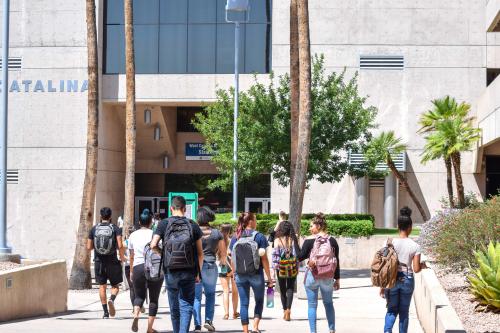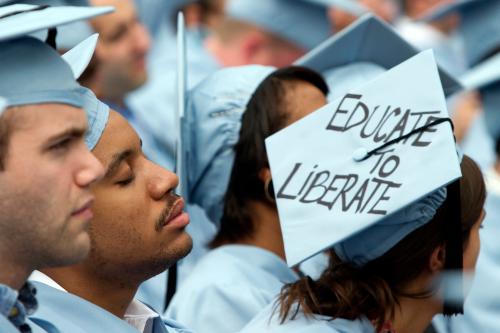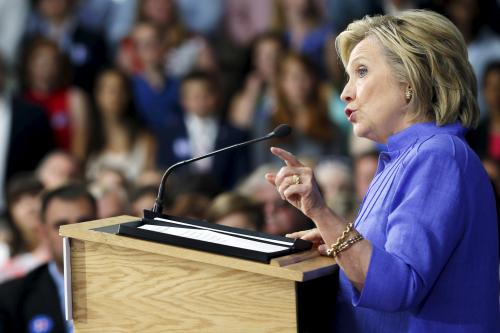With President-elect Joe Biden’s transition underway, let’s consider what may be in store for higher education. “The Biden Plan for Education Beyond High School” offers a broad proposal for making public higher education accessible to more Americans. The Biden plan has a number of features, but when it comes to free tuition, it draws heavily on the College for All Act of 2017 proposed by Sen. Bernie Sanders (I-Vt.) and Rep. Pramila Jayapal (D-Wash.). The headline news of the proposal is that the government will cover tuition at community colleges for all students and at four-year public universities for students with family incomes below $125,000, with the financial cost split between the federal government (67%) and the states (33%). On net, a very fine plan that would increase educational opportunities and raise national income. Nonetheless, some tweaking may be in order.
The benefit of the plan to students and families and the cost of the plan to taxpayers should be of wide interest. But because there are some potential landmines for how higher education institutions run, I want to focus here on improving the plan. (For a broader picture, I recommend a recent report, “The Dollars and Sense of Free College,” by Anthony Carnevale and his co-authors. It’s both informative and a pleasant read to boot.)
Now on to some of the rough edges in the plan.
Tuition vs. State Contributions
Here’s the issue: States differ in both tuition rates and in their financial support for higher ed. Because the plan brings in federal support for tuition, states that have kept tuition high get a bigger federal subsidy than states that have kept tuition low. For example, three states already have some type of free college program for eligible students at public four-year colleges, and 12 states have free community college programs. Here’s a picture for proposed federal subsidies for tuition at four-year schools:
Are we sure that we want to give Florida students and colleges only a fraction of the federal payments that we send to Vermont?
What’s more, some states have chosen to make relatively large appropriations to public higher education. As you can see in the next picture, states with low tuition tend to be the states with high (combined state and local) appropriations.
Penalizing states where the taxpayers have already stepped up to help keep down tuition doesn’t seem right. One solution would be for the federal government to send money to the states to partially offset state and local appropriations, on top of covering part of tuition. That would raise the cost of the program to the federal government, but with an equal reduction in cost to state taxpayers. Due to COVID-19, this may be a good time for the federal government to send extra money to the states. Alternatively, the feds could reduce their portion of the tuition-sharing rule and use the funds for sharing the cost of state appropriations.
Tenure-track faculty vs. adjuncts
The College for All Act requires that at least 75% of instruction be from tenured or tenure-track faculty within five years of enactment. The requirement is across each state, not within each institution, and each state has five years to meet the goal. Thus, there is some amount of flexibility.
If you follow trends in higher education, you know that one of the big changes has been the substitution of cheap adjunct positions for tenure-track positions, and that adjuncts are not treated well in many institutions. One report says that about a third of adjuncts make under $25,000 a year. In and of itself, shifting back toward tenure-track faculty would be a big and desirable change. Currently, very roughly 63% of full-time faculty are tenured or tenure-track. (However, the difference between 63% and the 75% target likely underestimates the size of the required change; there are almost as many part-time faculty as full-time faculty, and few part-time faculty are on a tenure track.)
There is a cheap and very bad way to comply with the new rule: just give tenure to a bunch of adjunct faculty in their current titles. No raises, no real change except better job security. Presumably, this is not what the drafters of College for All intend. Rather, the more likely intention is to shift back toward more tenure-track faculty. Since tenure-track faculty are more expensive than adjuncts, increasing the number of tenure-track faculty is going to cost money. Where is the money going to come from?
Tuition freeze and other cost controls
As parents of college-age students know, college has gotten a lot more expensive. For those who haven’t been faced with writing big checks, here’s a picture of the inflation-adjusted cost of tuition and fees at public universities. For comparison purposes, I include inflation-adjusted current expenditures per student in K-12.
While the rate of increase has slowed in recent years, the real cost of a college education is still going up. Not surprisingly, part of the Biden plan is to freeze tuition at current levels (except for adjustments for inflation) in order to hold down costs. If the feds pick up a big part of the tuition tab, it’s reasonable to ask what the incentives will be to keep “tuition” under control. Historically, there have been two elements limiting tuition increases: (1) the market and the willingness of families to pay, and (2) political control by state governments. Under Biden’s plan, the effectiveness of the first of these controls will be reduced; the second isn’t as clear.
Once tuition is free to students and families, there will no longer be so much of a market incentive to hold down on tuition. However, higher-income students don’t get tuition coverage, so there will still be a significant minority of students who will be price sensitive. In this way, the College for All Act does maintain some partial market incentives.
State legislatures currently have considerable influence over tuition rates and face political pressure to keep rates low. Political pressure would mostly disappear when tuition mostly disappears. On the other hand, because states would have to kick in one dollar out of three to cover tuition, they would have incentive to keep tuition low. It’s hard to know which of these two changes would dominate.
But isn’t low tuition clearly a good thing? Well, no. As any economist will tell you, putting on price controls leads to undesirable changes in the quality of the product that gets delivered. Universities are no different. In fact, there is a specific reason to expect that maintaining the quality of a college education will continue to become gradually more expensive. Higher ed is a labor-intensive industry, and people don’t get cheaper over time. (Economists call this “Baumol’s disease.”) In some ways, the closest comparison for thinking about long-term trends in the cost of higher education is the cost of K-12. Spending on K-12 is decided almost entirely by a combination of state governments and local voters. You can see in the figure above that the per-student cost of K-12 has increased in pretty much the same way as the cost of higher-ed tuition. Apparently, voters and political leaders have thought it worthwhile.
In addition to realizing that higher-ed costs will gradually rise because “people costs” will rise, there is also a cross-state argument. Some states have developed better colleges than other states. Some of this development followed from higher state spending and some from allowing for higher tuition. Historically, we’ve let each state decide on the trade-off between quality and cost. Freezing tuition will make it very hard for any state in the future to decide to increase quality. That’s probably not what we want.
Drawing a balance between preventing a free-for-all of colleges raising tuition versus the likely drop in quality as costs outrun current tuition levels isn’t easy. But an essentially complete freeze on tuition is probably a step too far in one direction.
The College for All Act contains a couple of other provisions that are intended to control costs but are ill-thought out.
First, the proposed plan bans use of any of the federal or state tuition replacement money “to pay the salaries or benefits of school administrators” or “for capital outlays or deferred maintenance.” Really? Colleges do need administrators. Who do they think is going to do the paperwork required to comply with the College for All Act? And no capital outlays? Does that mean my university doesn’t get the new classroom building that’s being planned for, even though an express purpose of the plan is to make college affordable for more people?
In the same spirit, the bill forbids charging “out of state students an amount that exceeds the marginal cost of attending.” Something like a quarter of students attend school out of state. Out-of-state tuition is typically much higher than in-state tuition. Presumably, students who go out of state, and their parents, find the extra tuition worthwhile. The truth is that out-of-state students often pay sufficiently higher tuition that they significantly subsidize in-state students.
What’s more, somewhat oddly, the College for All Act puts price controls on out-of-state tuition even though students going out of state are not eligible to have their tuition covered. This certainly means there will be fewer students going out of state. While I can understand limiting an out-of-state subsidy to the amount of in-state tuition, it’s hard to understand a rationale for eliminating out-of-state coverage entirely.
Finally, the most “out of state” you can get is, of course, the significant number of international students who currently bring large amounts of money into American universities and the surrounding communities. In fact, higher education is one of America’s most successful exports. In what is likely a completely unintended consequence, the bill as written forces universities to hold down the price charged to international students—thus managing to simultaneously reduce a source of subsidy to American students while also hurting our balance of trade.
The College for All Act would cut back on out-of-state tuition and out-of-state attendance. What would make up for the missing money in colleges’ budgets?
Knife-edge eligibility
One more weakness in the College for All Act is quite glaring. A student is eligible for tuition coverage if their parents earn $125,000 or less in adjusted gross income. In 2018, that was, on average, worth about $7,250 a year. According to the bill, if her parents’ income goes to $125,001, her tuition subsidy disappears entirely! This knife-edge cut off must surely be an oversight; almost all subsidy programs have a fade-out rule. One would expect to see something more like full tuition coverage for incomes up to $125,000, with coverage being reduced proportionately as income rose to some ceiling level, perhaps $175,000. As written, the College for All Act proposes a more than 100% effective tax on the first dollar above $125,000. Using $175,000 as a ceiling, just as an example, would reduce the extra effective tax to $7,250 out of $50,000, or 14.5%.
A better way to achieve college access for all
Make no mistake, Biden’s adoption of the College for All Act offers a major improvement on the status quo. Looking at the details though, there is room for improvement. While some of the issues discussed above may sound esoteric, they do matter if we are to improve access for all to high-quality higher education.









Commentary
Biden’s plan for higher ed is good—but it could be better
November 13, 2020